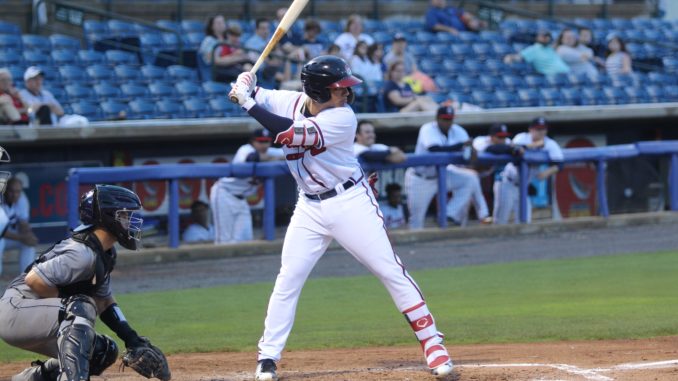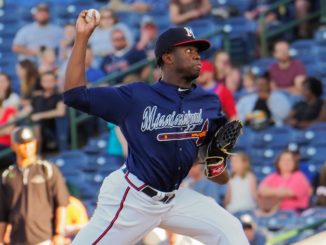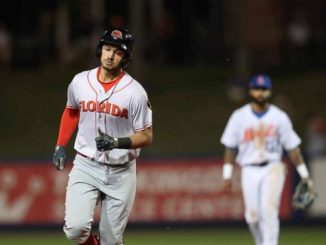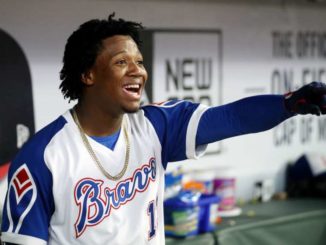
Spring training is less than month away, and though there will be acquisitions before (and possibly after) pitchers and catchers report, this series will take a look at the players mostly likely to suit up at each level of the organization.
The organization philosophy around catching from the majors on down over the last several years is to split the job close to 50/50 among two catchers (or 40/40/10 in three-catcher situations) which keep both engaged and fresh. This is particularly useful in the minor leagues, where most teams have access to the DH to keep the catcher not behind the plate that day in the line-up. As such, I’m going to give both main catchers at each level the “starter” label, and reserve the back-up section for situations with three catchers.
Also in this series:
First Base | Second Base | Third Base | Shortstop | Centerfield | Corner Outfield | Starting Pitcher
 ATLANTA BRAVES
ATLANTA BRAVES
STARTERS: Tyler Flowers and Brian McCann
For the last two seasons, the Braves have gotten top-5 MLB value from the catcher position. Over half of that value was do to the unexpected offensive surge of the now-departed Kurt Suzuki, but a big chunk came from the newly minted 33-year-old Tyler Flowers (appropriately, this piece is dropping on his birthday). Flowers had a little bit of a down season in 2018 at the plate, mostly due to making less contact. Making contact is a big deal for Flowers, because when he does he typically hits line-drives; in fact, average exit velocity was up a touch in 2018. If he can see the ball a little better, Flowers is a good bet for a bounce-back season, perhaps one reason why the Braves were quick to re-up with Flowers on a 1-year, $4 million deal in August. The other reason is Flowers’s defensive abilities, especially in the increasingly appreciated art of pitch framing.
Joining Flowers and replacing Suzuki is old friend Brian McCann. Reports out of ChopFest indicated that McCann was only interested in signing back with his hometown Braves or he would have retired, and the Braves took advantage of that single-mindedness by inking the former All-Star to a 1-year, $2 million. McCann should easily re-coup that value with his defense alone. McCann is widely regarded as one of the best pitch callers and game managers in baseball, a trait that the Braves should take advantage of by teaming him with some of the Braves top young pitchers such as Sean Newcomb and Touki Toussiant. McCann’s 2018 season in Houston was sabotaged by knee issues that shouldn’t come to a surprise for a soon-to-be 35-year-old catcher. McCann got surgery mid-season, returning to the big-league club in September. McCann looked markedly more comfortable at the plate, and it’s that short look that likely is what convinced the Braves to see if McCann had anything left in the tank.
The Braves have been strongly linked in the press as a potential landing spot for Marlins catcher J.T. Realmuto, and the presence of either Flowers or McCann would likely prove an impediment should the Braves end up making a trade for the All-Star.
 GWINNETT STRIPERS (CLASS AAA)
GWINNETT STRIPERS (CLASS AAA)
STARTERS: Alex Jackson and Raffy Lopez
The catching duo most likely to start the season with Gwinnett includes the veteran Raffy Lopez and the prospect Alex Jackson. Unlike last season when the Braves very often wanted to bring up a catcher to relieve a banged-up Suzuki or Flowers but had to deal with veterans like Chris Stewart and Carlos Perez not having options, both Gwinnett backstops in 2019 will be able to be freely called up and optioned back as needed. This flexibility cannot be understated, and it should go a long way to keeping the older Atlanta catching corps fresher throughout the year.
In addition to still having an option, Lopez is a strong defensive catcher with a solid .266/.340/.401 batting line at the AAA level, though given extensive playing time at the major league level in 2018 with San Diego, he was not able to take advantage of the situation, hitting a meager .176/.265/.284 in 37 games played. Lopez is 31 years old and would likely be the first man up in case of an early injury to one of the major league catchers.
As the season progresses however, the Braves no doubt hope that the 23-year-old Jackson makes his case to make his major league debut. A former first round pick by the Mariners in 2014, Jackson was acquired by Atlanta before the 2017 season and in December was added to the 40-man roster to protect him from the Rule 5 draft. Jackson has shown potentially massive power, but he had severe contact issues in 2018 while attempting to make adjustments to his swing. A catcher in high school but converted to an outfielder by Seattle, the Braves moved him back to catcher and his work behind the plate has been uneven, but gradually improving. Jackson shows the potential to be a good framer and pitch-caller, but has mobility issues behind the plate on balls in the dirt. Improvement in this area can overcome problems with the bat, or vice versa, and 2019 will be a key season for his future with the organization.
 MISSISSIPPI BRAVES (CLASS AA)
MISSISSIPPI BRAVES (CLASS AA)
STARTERS: Carlos Martinez and Jonathan Morales
The M-Braves will likely start the 2019 campaign with the catchers that they ended 2018 with. Carlos Martinez isn’t flashy or much of a prospect, but he’s a solid organizational catcher that can call a good game and won’t embarrass himself at the plate.
Jonathan Morales has all of the physical tools and leadership skills to make it be a big league catcher, but severe groundball tendencies combined with a high-contact oriented offensive game have sapped his offensive value. If he can start hitting the ball over the shortstop instead of to the shortstop, he could be an interesting weapon as a good defensive catcher that is also athletic enough to fill in at third and first base.
Top Braves catching prospect William Contreras could start the season with Mississippi if he has a strong spring despite only playing six weeks at the advanced-A level in 2018. If that occurs, it seems more likely that Martinez ends up in Florida.
Back-up: Being a third catcher in the minor leagues has to be a nerve-wracking proposition, but former 31st-round draft pick Sal Giardina handles is with aplomb. Giardina split his time evenly between AA and AAA in 2018, going wherever the organization needed him in between times that he was “injured” and stowed away on a disabled list. Giardina is solid behind the plate and can play first base as needed as well, and has maintained the #1 mustache in the organization for the last three seasons.

FLORIDA FIRE FROGS (CLASS A+)
STARTERS: William Contreras and Drew Lugbauer
The Fire Frogs will likely be home to three of the Braves top five catching prospects, most notably William Contreras. Contreras is starting to get more industry recognition after turning in strong offensive seasons in rookie ball in 2017 and in A-ball in 2018. Contreras has a strong, uncomplicated swing that generates hard contact all over the field. Behind the plate he has the makings of an above average defensive catcher, and he’s put in a lot of work on his mobility and footwork to nail down the technical side of the position over the last year. As mentioned above, there is a chance he could start 2019 in AA Mississippi with a good spring.
Lugbauer lead Rome in innings caught in 2018 after playing very little catcher for Michigan prior to being drafted by Atlanta in the 11th round in 2017. Lugbauer improved his defensive game enough to suggest that he can stick as a bat-first catcher, but the advanced-A level will be a challenge for him after he struck out at a 33% rate last season. There’s a chance that Lugbauer will return to Rome to at least start the 2019 season. Lugbauer can also work at first or third base to stay in the line-up, and despite the surge in strikeouts Lugbauer remains someone the team would like hitting every day due to the power in his bat.
Back-up: Former 2nd-round pick Lucas Herbert is arguably the best defensive catcher in the Braves minor leagues, but the bat has just not come around as hoped so far. Last year the peripheral metrics showed that he may have been the victim to some bad luck on balls in play, and Herbert hit nearly league-average in his second stint with Rome in 2017. Hopefully Herbert will continue that trend and work on his bat-to-ball skills enough to continue his path up through the organization. The best thing for him would likely be a quick promotion for William Contreras to Mississippi so he can get a larger share of playing time.
Organizational catcher Alan Crowley could also see work in Florida or Rome.

ROME BRAVES (CLASS A)
STARTERS: Logan Brown and Ricardo Rodriguez
Admittedly, this is a pretty big guess as the Braves have a number of catchers that played in the rookie leagues last season and none of them particularly stood out. Rodriguez and Brown got the most time behind the plate for Danville and the GCL Braves respectively, so that’s what I’m going on for now.
Rodriguez is entering his fifth season of pro ball after signing as a 16-year-old with the Padres as an amateur out of Venezuela. Rodriguez was traded to Atlanta for Christian Bethancourt, and has to toiled in the rookie leagues for the Braves the last three seasons, making it to Danville in 2018. Rodriguez has an intriguing set of tools and could be break-out candidate now that he has just turned 21 years old.
Brown was a 35th-round pick in 2018 who hit surprising well for the GCL Braves last year, even launching 3 home runs after only hitting 2 in his final year of college at the University of Southern Indiana.
Back-up: There are a lot of other options for Rome, and any of the following could see time with Rome, perhaps as soon as Opening Day.
Ray Soderman is a good catch-and-throw receiver that shows the makings of a good organizational catcher. While he isn’t likely to give a team much in the way of offense, Soderman could potentially fill in defensively at any level of the system and likely not miss a beat.
Rusber Estrada saw limited action with Danville last season and spend half of his time as a DH, but he was drafted with a good defensive reputation.
Victor De Hoyos saw his first stateside pro action in 2018, catching 19 games for the GCL Braves and appearing in 10 others. De Hoyos had the best offensive season of any of the catchers in the rookie leagues, and is strong candidate to see significant playing time in Rome. De Hoyos was an amateur signing out of Colombia in 2015.
At age 25, Zack Soria is the oldest of the catchers listed here. Soria’s offense mysteriously cratered in Danville last season after having a solid bat in college and in the GCL in 2017. Soria is a hard-nosed backstop with good leadership skills.
Catcher Depth Chart
- Tyler Flowers/Brian McCann
- Alex Jackson/Raffy Lopez
- Carlos Martinez/Jonathan Morales
- Sal Giardina
- William Contreras/Drew Lugbauer
- Lucas Herbert
- Alan Crowley
- Logan Brown/Ricardo Rodriguez
- Ray Soderman
- Rusber Estrada
- Victor De Hoyos
- Zack Soria
OFR TOP 5 CATCHER PROSPECT RANKINGS:
- William Contreras
- Alex Jackson
- Drew Lugbauer
- Jonathan Morales
- Lucas Herbert




Leave a Reply